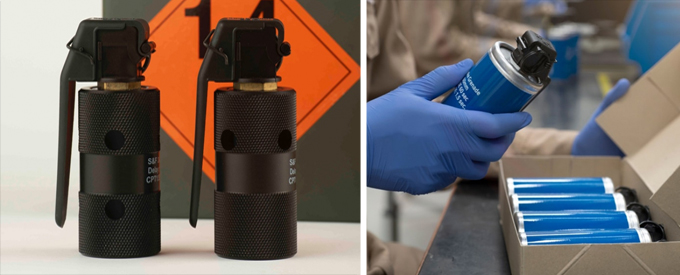2020-07-05
Non-lethal Weapons Hold the Key to Tactical Success

By: Mohamad Al Falasi
CEO of APT
Historically, militaries around the world have preferred to increase the lethality of weapons they deploy in conflict situations to achieve strategic dominance. However, in recent times we have seen a rising preference for technological advancement in non-lethal weapons (NLWs), as a more effective means to address today’s national security issues.
Though they might not be a top of mind association, NLWs have always been vital to gaining tactical superiority on various battlefields. The French frontline foot-soldiers in the First World War who threw smoke grenades into adversary German trenches to subdue and debilitate, offer a memorable example. Yet another is of the aerial cloud seeding tactics of the U.S. army in Vietnam in the early 1970s - an effort to prolong the monsoon season and give their equipment and weaponry a strategic advantage. It is clear from the examples that NLWs have been deployed with immense success as frequently as weapons of higher lethality, despite not getting the headline attention of ballistics and missiles.
Today, with the dramatic shift in the new physical and physiological strategic settings of warfare, technologically enhanced NLWs are set to become an indispensable component in achieving military objectives across the spectrum of conflict. For instance, with the novel coronavirus (COVID-19) pandemic sending the global economy hurtling towards a 3 per cent contraction, according to IMF’s projection in April, and a harsh new economic reality setting in with a rise in civil unrest across the globe, there is a clear and greater need for enhanced non-lethal capabilities.
With global military expenditure undergoing a review as national defence budgets tighten, nations that are able to procure the latest non-lethal technologies will have an edge over rival aggressor nations in the long-term. This advantage will enable them to refocus their training programmes on enhancing skill sets that could potentially alter the power balance in future battlefields.
As we continue to witness the rapid technological proliferation and focus on modernising defence strategies, the efficiency of future military operations will greatly depend on investing significantly in non-lethal effects against targets across all domains – air, land, sea, cyber and space.
Such has been the threat of civil unrest throughout the world in recent years that, according to data released in 2017 by global market research company Statistics MRC,1 the non-lethal weapons industry accounted for US$6.32 billion in 2016 and is expected to grow at a CAGR of 9.4 per cent to reach US$11.85 billion by 2023.
In the Middle East and North Africa, the NLW market is anticipated to register a CAGR of above 4 per cent of up to 2024.2 This growth is pegged to an increased emphasis on research and development, rising defence expenditures of emerging economies and a surge in the demand for small arms and light weapons.
It is, therefore, incumbent upon us, the developers in this field, to procure non-lethal technologies that can supply the demands of a world undergoing dramatic changes as it embraces the Fourth Industrial Revolution in a responsible and sustainable manner. One that adheres to the rules of engagement and upholds the integrity and preservation of the human race.
Technologically advanced non-lethal effects offer military and armed forces the capability to disperse and neutralise potential threats. NLWs are today characterised by four distinct components: their ability to incapacitate, the reduced collateral damage they inflict, the reversibility of their effects, and their power to deter.
Nowhere is this more integral than in the theatre of war itself. While lethal force is necessary to successfully wage war, it is unsuitable when it comes to leaving behind a safe, secure space and to instilling peace – as we should have learned from the history books.
Furthermore, NLWs are proving to be a more effective means to arm and protect friendly forces and their allies without contributing to civilian death tolls and without destroying the vital civil infrastructure on which their future depends.
As we have seen with wars around the world, the exit phase can often be marred and disrupted by looting, sabotage and insurgency. If foot soldiers have recourse to an effective non-lethal arsenal — an integrated training programme that instilled the essential use of NLWs to deescalate, disperse and neutralise hostile civilian crowds — the goals of modern warfare can be achieved with greater efficiency.
The tactical NLWs being manufactured and tested at APT’s advanced pyrotechnics laboratory in the United Arab Emirates offers solutions for the tactical superiority of the armed forces, security forces and law enforcement units around the world.
From high-quality smoke grenades and low-velocity projectiles for signaling, masking training and crowd control, the pioneering modern defence tools will elevate the way militaries and civil defence teams are able to deescalate, control and carry out close-in engagements for peacekeeping missions.
Whether it’s a police force with the ability to disarm a distressed weapon-carrying criminal in a domestic setting without having to resort to lethal force, or simulated real-world conflict environments for armed forces training, or indeed, a given military’s enhanced readiness to peacefully neutralise potentially violent outbreaks of civil discontent, NLWs hold the key to achieving tactical superiority across the spectrum of conflict in the modern world.



No Comments